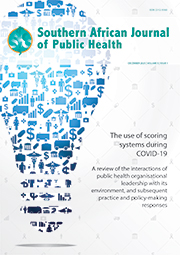Articles

Rapid assessment of two primary health clinics: Are we ready for National Health Insurance?
Abstract
Background. Healthcare service delivery remains a challenge in most primary healthcare (PHC) facilities across South Africa (SA). In addition, the healthcare system continues to have high and rising costs, with widening gaps in quality, equity and access. The National Department of Health (NDoH) launched the National Health Insurance (NHI) pilot programme in 2012 as the solution to the current ailing health system. The NDoH’s strategy is to improve all PHC facilities to meet the standards of an ‘ideal clinic’ (IC) in order to improve access to quality health services.
Objectives. To assess the challenges experienced by two NHI pilot clinics in the provision of healthcare.
Methods. A descriptive cross-sectional study was done in a province in SA, at two NHI pilot clinics. Data were collected using structured questionnaires that used the component elements of the IC model framework. Data were captured in Excel, and analysed using Stata 13 software.
Results. Forty-six clinical and administrative staff participated in the study. The majority (84%, n=38) of participants were female. Clinic A had not been designated as an IC. There was no statistically significant difference (p>0.05) between the two clinics in their global self-scoring regarding service provision. Human resources and medicine supply shortages were reported as challenges affecting service provision. All (100%, n=22) clinic A participants reported not having a doctor, while 82% (n=18) reported not having a pharmacist. Clinic B had IC status, and all the participants (100%, n=24) confirmed the availability of the doctor, while 88% (n=21) reported the availability of a pharmacist. The clinics reported a range of 5 - 180 minutes of patient waiting time after triaging; however, there was no statistically significant difference found in the patient waiting times between the two clinics (p=0.96).
Conclusion. Both clinics are NHI pilot clinics, yet there are reported disparities regarding the equity of resources, which could affect effective service provision. Both clinics should have been operating at a similar standard under the NHI pilot programme.
Authors' affiliations
A Motsepe, School of Health Systems and Public Health, Faculty of Health Sciences, University of Pretoria, South Africa; Department of Radiography, School of Medicine, Sefako Makgatho Health Sciences University, Pretoria, South Africa
E Webb, School of Health Systems and Public Health, Faculty of Health Sciences, University of Pretoria, South Africa
J E Wolvaardt, School of Health Systems and Public Health, Faculty of Health Sciences, University of Pretoria, South Africa
Full Text
Cite this article
Article History
Date published: 2020-03-19
Article Views
Full text views: 1186

.jpg)


Comments on this article
*Read our policy for posting comments here